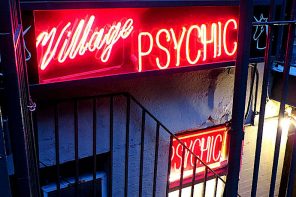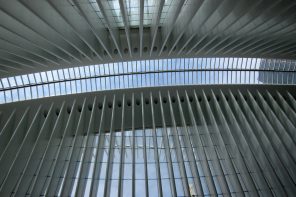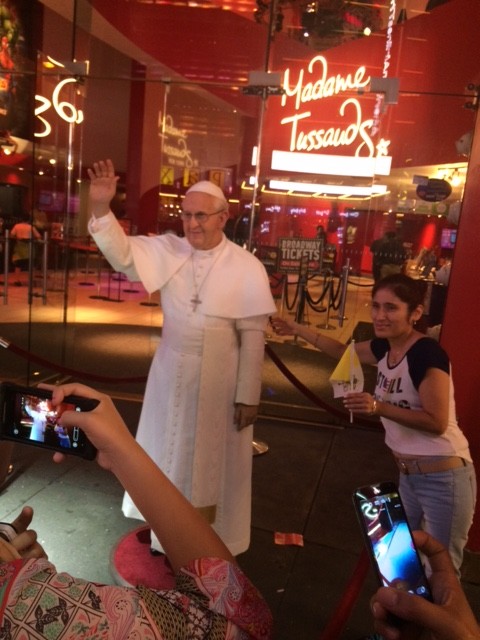Looking at the online flood zone map of our neighborhood, I feel calm.
I’m a bit of a map freak and I appreciate how clearly this one presents the information and how easily I can navigate within it. I know, vaguely, that the East Village is vulnerable to flooding from the East River but now I can see the facts. Zooming in, I see the exact boundaries of Zone A—the mandatory evacuation zone. It extends from the river up to the public housing blocks along FDR Drive, to the German Biergarten on Avenue C, up to Sheens on Avenue B, the bodega where you can spend $8 on a carton of milk and toilet paper.
We live just to the west of Avenue B—bright red on the map, along with everything to the east. Mayor Bloomberg has ordered everyone living in the Red zone to evacuate. The storm looks big on the satellite images, really gnarly.
I zoom in closer to make sure. Yes, our building is just on the other side of Zone A. From our door I could easily toss a rock at Sheens, which is in Red. But we are in Zone B: Orange. And Tompkins Square Park, right across the street from us is Happy Yellow, Zone C, with the lowest risk of flooding.
The upshot is that the three flood zones intersect exactly where we live at East 10th Street and Avenue B.
A part of me knew it was absurd to pin my sense of security to a digital map. First of all, I didn’t want to be looking at it in the first place. If we had lived on higher ground it would have been moot and I would not have made a religion out of understanding the distinctions between zones A, B, and C.
But I was only staying in the East Village for a few months. Much was unfamiliar already: my new relationship, being unemployed, the neighborhood itself. So with the largest hurricane ever to threaten New York City headed our way, I just gave myself over to it. I knew it could not really satisfy my longing for comfort and order but it was the best thing I had.
We’re in Zone B, barely. We decide to stay.
*
That afternoon, before the storm hit, I had walked east into the Red Zone. Three yellow school buses were idling at the entrance of the Jacob Riis House, public housing near the river, to transport residents to emergency shelters. There were only a few hours left but I didn’t see many people getting on.
I asked a woman with the leathery face of a smoker who was walking her small dog in the already strong wind outside the building what she was planning to do. “I’m not going,” she said without a trace of hesitation. “I’ve lived here my whole life. My daughter has Down Syndrome. And where would we go?”
“But you’re in the red zone,” I said. “Aren’t you scared?”
“I live on the 12th floor. We’ll board up the windows.”
*
The hurricane reaches the coast around 6 p.m. We watch its arrival on our big TV, snuggled under a down comforter. The weather graphics show the eye of the storm moving closer and closer to the New Jersey coastline. The closer it gets, the stormier it gets outside. My attention flickers between the virtual hurricane on TV and the rattling and cracking and whooshing sounds of the massive winds now hitting the neighborhood.
There is a huge explosion; a flash lights up the whole sky. Then another. And another. I have no idea what is going on. I picture our exact location on the flood zone map. I see every pixel in my mind’s eye and assure myself again that we’re in Orange, not Red. We will be OK. The news anchors aren’t saying anything about the explosion. The TV flickers, then the lights, then everything is dark everywhere.
The next day we wake up in the dark, light candles. We turn on the battery-powered radio and learn that what we had heard was a power station on 14th Street, about eight blocks away, blowing up. The narrow stairway of our fifth story walk-up is pitch black. Our phones have no signal, which means no AP alerts, no Facebook, no Twitter—and no way to contact friends and family. Except for the radio, we’re cut off. And so is everyone else in the mass of humanity that lives and works below 39th Street.
In the afternoon, after the worst of Sandy has departed for the north, I walk across Avenue B again into the Red zone.
Some time during the night the East River, which is really part of the ocean, flooded over the boardwalk, sending long tongues of salty seawater onto FDR Drive and into city streets. As I walk down 10th Street toward the river, I read the signs of the water’s path: parked cars askew in the street, on the sidewalk; flooded basement after flooded basement; ribbons of detritus strewn in patterns that look like the banks of a rushing stream. As if it had been following the outlines of the map the flood stopped just short of Avenue B, not touching our Orange side of the street.
*
Zooming in, zooming out—calculating the odds. It gave me a desperately needed illusion of control in the face of the unknown of the storm. And if nothing else, it reminded me that I could leave.
But for people like the woman I met in front of Jacob Riis, who lived unequivocally in the most dangerous area but felt she couldn’t leave, no matter what the risks, the map must have meant something different, something like “duh.”
It showed her what she already knew—that she lived in the evacuation zone—but offered no easy solution.
*
Almost a week after Hurricane Sandy I know the neighborhood much better than before. Sheens remained open throughout four days of no power and sold us batteries and cigarettes; they were expensive, but they were there.
The owner of the Italian restaurant downstairs who lost five large freezers full of food when rising ground water swamped his basement loaned me his phone.
At the bar of a French restaurant that opened the day after the hurricane to serve red wine in plastic cups by candlelight, I learned that the proprietor had recently been convicted of starting a fire in the building during a bout of depression. The hurricane had made things worse, but he was going to lose his business anyway.
This man, whom I had just met and who would be in jail in a few days, refilled our cups. “Thank you for your support,” he said. We drank a toast.
None of this was on the map, exactly, but it was what I was looking for.




